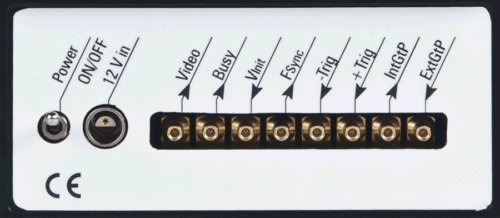Trigger options of high speed ICCD cameras
The image intensified high speed cameras from Stanford Computer Optics provide multiple trigger options to fulfill the requirements of many different fields of application. In most cases the ICCD cameras are operated as trigger slaves, where the trigger pulses are generated elsewhere in the experimental setup and the camera is synchronized with the external pulse generator. However, some applications need to operate the ICCD cameras as trigger master and supply the internally generated trigger pulse to further components of the experimental setup. Certainly, both cases can be combined with the ICCD camera from Stanford Computer Optics. The camera trigger pulse initializes the optical gating by the photocathode and under certain condition the readout of the CCD sensor from the camera image.
Trigger options of the high speed ICCD cameras

Input trigger connectors of the intensified CCD camera
-Trig/+Trig: Input connector for TTL trigger pulses of an external trigger sources sensitive on negative/positive edges. The transition at 1.3V and the input is resistant for short time period up to max. 20V.
ExtGtP: Input TTL connector which provides direct access to the photocathode gating via external TTL signal. A negative logic CMOS signal is necessary (low for shutter open) and its transition voltage level is 2.5V.
Additional input trigger options of the XXRapidFrame framing camera:
High voltage (100V): Input connector for high voltage trigger pulses up to 100V.
Optical fiber connector: Trigger input connector for trigger signals provided by a optical fiber.
Output trigger connectors of the intensified CCD camera
Busy: Output TTL signal of timing circuitry signal can be used as external trigger signal for a frame grabber or other instruments. It is an active low signal which can be changed on request to active high.
Fsync: Output TTL signal which provides a reference signal synchronous to the internal CCD sensor in free running mode.
IntGtP: Output TTL signal which provides a photocathode gate monitor for reliable timing information on actual
gating occurrence independently from the trigger signal of the camera.
Trigger delay of intensified CCD cameras
The intrinsic delay time of the ICCD camera needs to elapse in every case after the external trigger signal and before the photocathode gate will be opened. The intrinsic delay time of the ICCD camera from Stanford Computer Optics is 60ns for internally controlled gating pulses and 30ns for external controlled gating pulses via ExtGtP connector.
Regardless of the camera usage, as trigger slave or trigger master, the internal trigger delay unit is able to synchronize the time slot of the gating pulse to the experimental event which is under investigation. Therefore, a digital, remote programmable, built-in trigger delay unit is supplied as standard with all ICCD cameras from Stanford Computer Optics. Therefore, any additional delay after the trigger signal can be easily adjusted in time delay steps of 100ps (4 Quik E) or 10ps (4 Picos) via remote software control console. The shortest incremental delay steps of 10ps allow fully time resolved sub-nanosecond fluorescence lifetime imaging microscopy.
Highest trigger repetition rate for high speed optical gating
If the camera operates as trigger slave it is possible to operate the optical camera gate at much higher frequencies than the frame rate of the CCD sensor. By default all ICCD camera from Stanford Computer Optics provide a photocathode gating repetition rate of 200kHz (continuous up to one hour, longer times may cause damage of pulse amplifier). Optional available is a repetition rate of 2MHz (5MHz on request).
In this multiple exposure mode the built-in single trigger pulse discriminator is able to pick out the first trigger pulse only or a certain number of trigger signals and ignore the succeeding ones. The trigger pulse discriminator also allows a freely programmable number of accepted trigger signals up to a maximum of 127 trigger signals per frame.
An trigger setup example with the ICCD camera:
Integration of a high speed ICCD camera to an experimental setup of electrical discharge research. The external trigger pulse may be derived from the ignition pulse which drives the electrical discharge unit. It will take some time til the breakthrough has proceeded. Thus, the gating must be delayed by this time regarding to the incoming trigger pulse. In this case, the user simply set the internal delay time to the desired time by the remote software control to precisely adjust the exposure relative to the electrical breakthrough. With the ultra fast gating capability of the 4 Picos ICCD camera it is possible to scan through the temporal process of the discharge.
If the camera operates as trigger master it will be necessary to delay its internal gating with respect to the internally generated trigger pulse.
